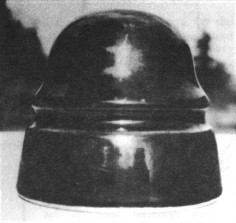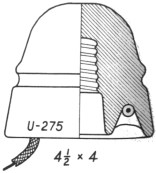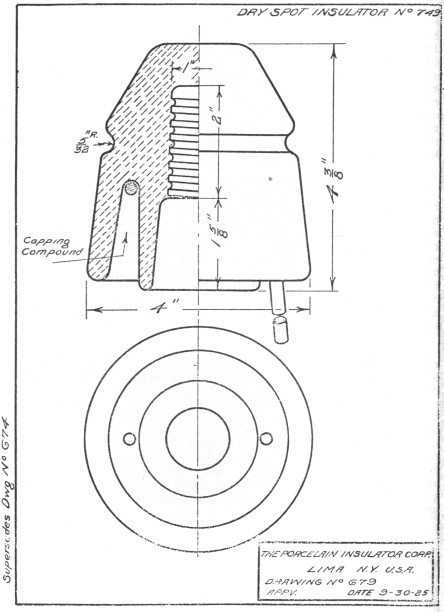Porcelain Insulator News
by Elton Gish, NIA #41
Reprinted from "Crown Jewels of the Wire", October 1985, page 20
Dear Elton,
I recently purchased an insulator that I thought you may find of interest. My fat friend was found at a flea
market and I cannot find a U-number
for it (See photo below). An insulated wire is imbedded in the groove
between tie petticoat and the skirt and has been checked for continuity.

It is
4-1/2 inches wide and 4 inches tall and looks fat. It has an incuse marking
consisting of an insulator insignia with LOCKE R=oo inside.
Jeanne Bridges, NIA #1027

- - - - - - - - - - -
Dear Jeanne,
Your "fat friend" is a real goody, and is about the best find of
the past couple of years. Your thought that I may find it of interest is a
pretty big understatement! It would be nice to place it next to it's compatriots
U-173 and U-174, but there have been so many precedents of putting like shapes in groupings
that we're stuck with making this new thing U-275 (where its' in with like shapes).

The U-275 is a dry-spot insulator, the exact same thing as the U-173 and
U-174 that were made by Pinco in the late 1920's. In these, the insulator in
designed with a very deep groove between the skirt and interior petticoat. An
insulated wire is placed around the depths of this groove halfway around with
each end being bent down out of the groove on opposite sides. Then the groove is
filled with a tar or other potting compound. Needless to say, this arrangement
affords the necessary dry spot on the insulation of the embedded wire -- thus
breaking the leakage path along the wet insulation of the bridle pair connected
to the open wire line.
The dry-spot was used on a telephone circuit where a tap into the line was
desired. To prevent the circuit from becoming unbalanced during wet weather,
resulting in crosstalk, the insulated tap wire is provided a dry section, by the
dry-spot insulator, of several inches to break the leakage path. Naturally, a
pair of this type insulator would be needed for each phone tap, one for each of
the two leads. A more practical and serviceable dry-spot is the U-I 88 which is
specially designed to make dry spot provisions for both phone tap lead wires
within in the insulator. The more practical U-188 was manufactured for about 30
years.

The dry-spot insulators were made with a tie-wire groove. One of the normal
conductor insulators was removed and replaced by the dry-spot which then
accommodated the conductor wire and provided the tap wire and dry spot. As an
alternative, the dry-spot was mounted on the peg of a transposition bracket
underneath the crossarm. Further detailed discussion of dry-spots can be found
on pages 121 and 153 of Jack Tod's book Porcelain Insulators - Guide Book
for Collectors, 2nd edition and CJ article 9-73-18.

Large Image (140 Kb)
The U-275 is of great interest because of the 2-26-1929 patent on this scheme
by Postal Telegraph Cable Co. -- the Insulators (styles U-173 and U-174) being
made by Pinco. The Locke marking on your "fat friend" was used from
1922 to 1928. The year that your item was made by Locke is very important, since
it could have been considerably prior to the 4-29-1927 filing of the patent (see
Jack Tod's new book, Insulator Patents, 1880-1960, Tod class 52). Naturally,
things are not patentable If they have already been invented and made by someone else at a prior
time, whether or not the originators
filed for a patent. A patentable item must be novel and also an original
invention, not a copy of someone else's prior scheme. A drawing of the dry-spot
style was made by Pinco dated 9-30-1925 (shown on the preceding page) . Pinco
was evidently manufacturing the dry-spot, it only experimentally, as early as
late 1925. Possibly the nearby Locke plant at Victor out-bid Pinco on an order
in the 1927-1928 time period before the Victor plant was closed in 1928 and
subsequent discontinuation of the Locke R=oo marking. The U-174 version carries
both the Pinco marking and the underglaze ink marking shown below.
Elton

In February 1985 CJ page 23, we ran a list of known Pittsburg date control and
full date markings and a request for your reports of markings not shown on that
list. We must have had a near complete list as only two people responded with
new reports.
A. L. Rash reported the unusual JAN-9 919 marking. The marking was deep and
clear but there was no indication of the "1" in the year
"1919". This year is very late in Pittsburg's history.
Frank Phelps caught all of us asleep with three new reports: APR 30, MAY 2
and May 6 all from 1913.
Also note the typo error which should read "AUG 12 Rec'd" instead
of the month "APR". The updated list appears on the following page and
we welcome any new additions. New reports will be published individually.
|
KNOWN PITTSBURG DATE CONTROL MARKINGS |
|
JAN 16 Rec'd
|
APR 6 Ans'd
|
|
APR 11 Rec'd
|
APR 13 Ans'd
|
|
AUG 12 Rec'd
|
MAY 25 Ans'd
|
|
SEP 20 Rec'd
|
JUL 26 Ans'd
|
|
|
NOV 30 Ans'd
|
|
APR 21 A.M.
|
|
|
|
JAN 18 Ent'd
|
|
|
NOV 15 Ent'd
|
|
JAN 17 PAID
|
|
|
FEB 16 PAID
|
|
|
JUN 26 PAID
|
APR 12 P.M.
|
|
JUL 8 PAID
|
APR 16 P.M.
|
|
AUG 26 PAID
|
JUL 7 P.M.
|
|
NOV 15 PAID
|
NOV 25 P.M.
|
|
NOV 21 PAID
|
|
|
KNOWN PITTSBURG FULL DATE MARKINGS
|
|
APR 22 1913
|
|
APR 30 1913
|
|
MAY 2 1913
|
|
MAY 6 1913
|
|
JUN 5 1913
|
|
JUN 17 1913
|
|
MAY 2 1915
|
|
NOV 7 1915
|
|
AUG 16 1916
|
|
JAN-9 919
|
| 